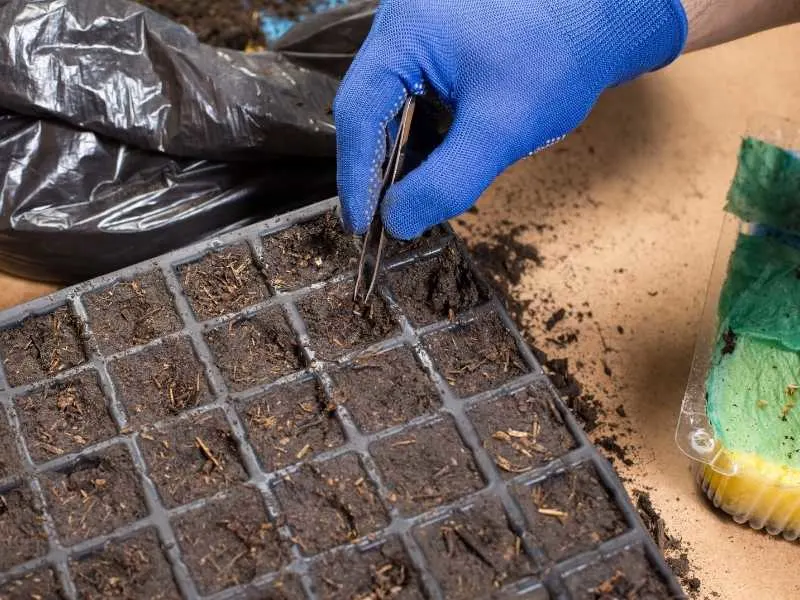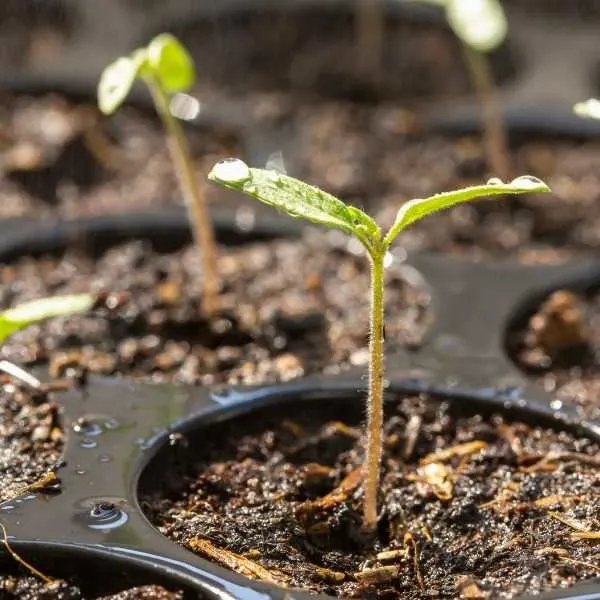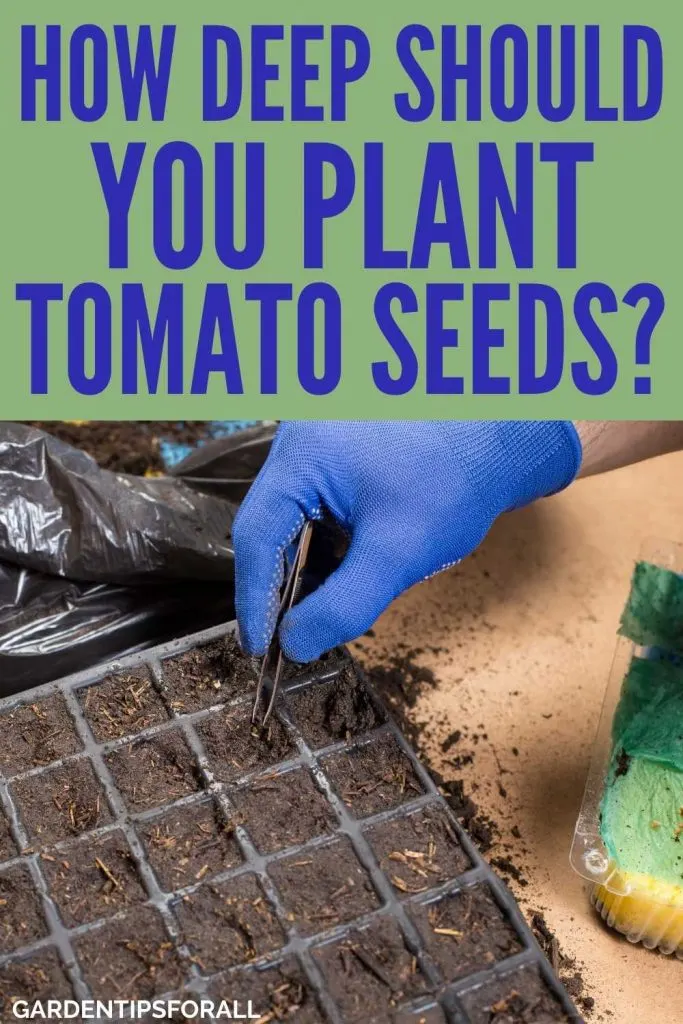How Deep Should You Plant Tomato Seeds?
Tomatoes are some of the most rewarding vegetables you can grow. We all want to produce those large, red, and juicy fruits. But it’s not always easy.
One of the issues beginners struggle with is how deep to plant tomato seeds. And I have had some of my readers ask, how deep should I plant tomato seeds?
So, how deep should you plant tomato seeds?
The ideal depth to plant tomato seeds is between 1/8 and ¼ inch into the soil. A rule of thumb is the depth of the hole should be twice or thrice the seed’s diameter.

Keep reading to learn more about the ideal depth to sow tomato seeds and other vital tips for growing tomatoes from seeds.
Related Articles:
- Do You Have to Dry Tomato Seeds before Planting?
- What Size Grow Bag for Tomatoes Should You Use?
- Best Soil for Growing Tomatoes in Containers
- Best Manure for Tomatoes
How Deep to Plant Tomato Seeds
As mentioned earlier, the seed’s diameter should guide you on how deep you should plant it. That means small seeds should be planted with very little soil covering them, while larger seeds should be planted deeper.
Why? Large seeds have enough food to grow the sprout through the soil, unlike small seeds like those of tomato plants.
What Happens if You Plant Tomato Seeds too Deep?
Below are some of the effects of planting tomato seeds too deep:
- Failure to Germinate or Slow Germination – IF you plant tomato seeds too deep, they may fail to germinate, and those that do will germinate slowly since they have to “overwork” to emerge from the soil. Besides, the conditions deeper in the soil may be unfavorable to these seeds compared to the topsoil.
- Delayed Growth – Since the seeds spend too much time in the soil, they will not grow as they should above the soil. And without proper growth, you will get little to no yields from the tomato plants.
What Happens When You Plant Seeds too Shallow?
If you plant tomato seeds too shallow, they may not thrive. The roots will only spread horizontally, they’ll not give enough support to the plants, and they’ll not provide the necessary nutrient uptake to the plants.
How to Grow Tomato Plants from Seeds

Don’t let the issues mentioned above scare you. When done right, growing tomatoes from seeds is one of the best ways to grow tomatoes. It’s cheaper, you have more control over how to grow the seeds, and there’s a wide variety of seeds to choose from to get higher yields.
Planting
Below is a step-by-step process of planting tomato seeds.
- Start by finding a suitable place to plant your tomatoes. I prefer seed starter trays since they have clear compartments to plant your seeds.
- You can choose to make your own potting mix or buy a seed starting mix. But avoid using garden soil.
- Moisten the soil by sprinkling water, then fill the compartments with the moistened soil mix and press it to eliminate air pockets.
- Using a pencil or your fingers, poke 2 to 3 holes in each compartment on the tray. The holes should be between 1/8 and ¼ inches depending on the size and variety of the seeds.
- Place a seed in each hole, sprinkle some soil mix to cover the seeds, and press it down gently to firm the soil.
- Gently water the seeds.
- Cover the containers and place them in temperatures ranging from 70 to 80 degrees F for fast germination.
- Monitor the seeds over the next few days, ensuring the soil mix is moist. The seeds should take at least two weeks to germinate.
- When you see some sprouts, you can move them to grow lights and consider removing the cover.
Tips for Caring for Your Tomato Plants Once they Germinate

Tomato plants need care and shouldn’t be left untended. It might take up to three months or more for your plants to begin producing fruit, so you’ll need to keep an eye on them for the long haul.
#1. Watering
Tomato plants prefer moist soil, but not soggy or waterlogged. Watering your plant first thing in the morning helps ensure that it has enough moisture to last all day.
You can also use a self-watering seed starter to prevent watering issues. You simply fill it with water, and it will control how much water gets to the individual plants.
You may want to read this detailed article on how self-watering planters work.
#2. Thinning
This entails eliminating the weak tomato plants in each tail by cutting them at the soil level. You do this when the plants are about 2 inches tall.
#3. Remove the Suckers
“Suckers,” or side branches that grow where a leaf connects to the main stem, may draw nutrients from the plant and need to be removed regularly. Doing this will help the plant to grow upward rather than outward.
#4. Fertilize
Start fertilizer application when you notice the appearance of two sets of leaves on each pant.
Ensure the fertilizer contains enough phosphorus to help in the growth process and production of fruits. Potassium and nitrogen are important too. But too much nitrogen can lead to fewer flowers and, in some instances, no fruit.
#5. Repot the Tomatoes
After a few weeks of growth, uproot one of the tomato plants and check the roots. If they fill the soil around the roots, repot them to a larger container. Again, keep watering and keep the tomatoes under grow lights for a few more weeks.
#6. Transplanting
If it’s warm outside, preferably in the summer, and there’s no frost, you can consider transplanting the seedlings outdoors. If not, always repot them to larger containers as they get bigger.
#7. Stake your Tomato Plants
Staking your tomato plants helps to keep them upright as they grow. You can use these tomato cages for better support.
#8. Keep Pests Away from Your Tomatoes
Check under the leaves, under the fruits, and near the soil daily to ensure that there is no pest infestation and that your tomato plants are doing well. Spray plants with a strong jet stream from the hose to prevent pests like aphids.
With gloves on, handpick larger insects like tomato hornworms and drop them into a bucket of soapy water.
Furthermore, you can use insect nets to protect your plants from pests such as thrips and aphids, which primarily damage leaves and flowers.
How Deep to Sow Tomato Seeds – Conclusion
The ideal depth to sow tomato seeds is between 1/8 and ¼ inch into the soil. Planting your tomato seeds in the right depth, and caring for your tomato plants following the steps provided here will help you grow healthy tomato plants so you can have a bounty harvest of juicy fruits.

